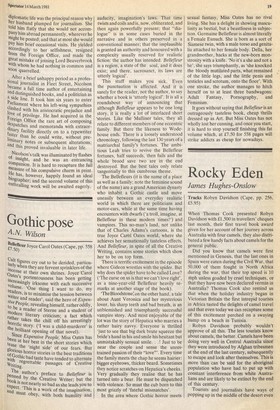Rocky Eden
James Hughes-Onslow
Tracks Robyn Davidson (Cape, pp. 256, £5.95) When Thomas Cook presented Robyn Davidson with £1,500 in travellers' cheques last month, their first travel book award given for her account of her journey across Australia with four camels, they also disttibuted a few handy facts about camels for the general public.
Did you know that camels were first mentioned in Genesis, that the last ones in Spain were eaten during the Civil War, that 50,000 of them fought in North Africa during the war, that their top speed is 10 mph unless goaded by cruel techniques, or that they have now been declared vermin in Australia? Thomas Cook also remind us that when the holiday industry began in Victorian Britain the first intrepid tourists in Africa tasted the delights of camel travel and that even today we can recapture some of this excitement perched on a swaying hump on a beach in Tunisia.
Robyn Davidson probably wouldn't approve of all this. The less tourists know about camels, the better. Camels have been doing very well in Central Australia since' they were introduced by Afghan tribesmen at the end of the last century, subsequently to escape and look after themselves. This is more than can be said for the aboriginal population who have had to put up with constant interference from white Australians and are likely to be extinct by the end of this century.
Tourists and journalists have ways of popping up in the middle of the desert even without the assistance of camels and Miss Davidson had to devise some long and painful detours to avoid them. They ask silly questions and then pass on garbled reports and photographs to newspapers. By the time she had completed her 1,700 miles across the desert the reputation of Australia's mysterious camel lady was pretty well-established. She must be completely mad.
It takes time to acquire a liking foi camels. They are disobedient, dangerous, jealous and thieving and, when trying to be friendly, they cover you with stinking green slime. They often disappeared in the night, only to be found after days of careful tracking. On several occasions they nearly killed her. But she says 'they are affectionate, cheeky, playful, witty, self-possessed, patient, hard-working and endlessly interesting and charming.' In a word, almost human.
Human? Well, European. The aborigines, at least the few lucky enough not to have had any contact with western civilisation, don't seem to have any human vices. It will surprise most people to learn that they are civilised at all but the truth is that they have a sophisticated code of respect for the land and for each other which has enabled them to survive for centuries in an environment which to white people still seems totally hostile. They come unstuck when confronted with 20th-century capitalism because they have no idea of property. 'To these old people, the concept of owning land was far more impossible than owning a star or an allotment of air would be to us.'
Robyn Davidson was lucky enough to meet a dignified and much respected elder of the Pitjantjara tribe who accompanied her for several hundred miles. Although he spoke no English he was able to introduce her to the gastronomic delights of the bush. 'He was sheer pleasure to be with, exuding all those qualities typical of old Aboriginal people — strength, warmth, self-possession, wit, and a kind of rootedness, a substantiality that immediately commanded respect.' Yet when confronted with a convoy of camera-laden tourists he put on a spectacular display of aggression, turning himself into a perfect parody of the murderous savage and raving idiot they expected him to be. This is apparently a standard joke among the ahos, designed to make people leave them alone.
She obviously resented the various outside pressures which prevented her getting to know the aborigines better; the photographer, for example, from National Geographic magazine, her sponsors, who alienated her tribal friends by photographing secret ceremonies. The tourists and the press ruined the tranquillity of the trip towards the end but they did help her to illustrate the hopeless contrast between black and white Australians. The very notoriety which she wanted to avoid may even cause a few Australians inadvertently to read about the oldest civilisation in the world before they finally destroy it.







































 Previous page
Previous page